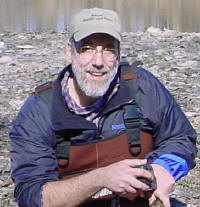
M. Christopher Barnhart Curriculum vita (pdf file). Publications at Research Gate. Commentary about the Biology program at MSU. Retrospective 2017 on STEM Spots Radio Research Interests
Roston Butterfly House
The Roston Native Butterfly House (RBH) is located in the
Springfield Botanical Center in Close Memorial Park.
RBH is an educational
resource, free of charge to visitors, and operated by
volunteers.
As curator,
I provide training for
docents, raise butterflies and moths for display, and develop
interpretive materials and infrastructure.
I work with a group of about 40
docents. We display the entire life cycle of
native species, complete with host plants, predators and
parasites, and use these to teach ecological lessons and the
importance of native wildlife.
The Butterfly House is a great
resource for teachers, and we distribute hundreds of
caterpillars to classrooms each year.
RBH receives over 30,000 visitors
annually.
http://friendsofthegarden.org/butterfly-house Courses
Biology 121, General Biology I Biology 121 is the first half of a two-semester biology sequence. It is the first course in the required "core curriculum" for biology majors and is intended for students who plan to take further coursework in the life sciences, including biology majors and minors, wildlife majors, premedical students and others. Biology 121 introduces molecular and cellular biology, genetics, and evolution. The second course in the sequence (Biology 122) covers biological diversity, physiology and ecology. Students desiring a one-semester introductory Biology course for general education purposes should consider Biology 102, Survey of Biology. Biology 539/639 Biogeography Biogeography is the science of the spatial patterns of biodiversity. Simply stated, it attempts to describe and explain which organisms live where, and why. Biogeography is both one of the oldest areas of science and one of the youngest. This is a 3-hour lecture course intended for both graduate and upper-division undergraduate students.
Biology 370: Invertebrate Zoology The main theme of Bio 370 is animal biodiversity. We consider the anatomy, physiology, behavior, and life history of most of the animal and protist phyla and review the principles of evolutionary biology, phylogeny, and the history of life on earth. Comparative biology is another important theme- we compare the various groups for rules of similarity and general principles in biology. Who should take this course? People who are truly interested in organisms and who have a strong background in Biology, including genetics, cell biology, and ecology. If you plan to go into teaching, Biology 370 is a useful course. If you are thinking about graduate school and want more breadth to help you find your interests- this is a good course. Bio 370 is also relevant to those interested in medicine, because invertebrate parasites of man and domestic animals have tremendous medical, economic & social significance. Biology 574/674 Aquatic Entomology Aquatic insects are fascinating, diverse and ecologically indispensible members of aquatic ecosystems. Knowledge of freshwater insects is one of the most valuable skills for aquatic ecologists, because the aquatic insect community is a widely used measure of the biological integrity or condition of freshwater habitats. What we’ll do: ·Lecture (basic biology of aquatic insects, use in biotic inventories) ·Class presentations on the Orders and Families ·Field collecting trips ·Preparation of student collections ·Learn to identify aquatic insects About the Biology Department at Missouri State The Biology Department at Missouri State consists of 20 faculty, about 50 graduate students, and 600 undergraduate majors. Several of the faculty (Finn, Kissoon-Charles, Mathis, Barnhart are particularly interested in aquatic biology. Our physical location in the Ozarks provides access to a variety of habitats, including many excellent streams, rivers, and lakes. Our field station at Bull Shoals Lake on the White River provides unique opportunities for teaching and research. Inquiries from prospective students (BS, Masters) are welcome! Last update: 10/01/17.
|




